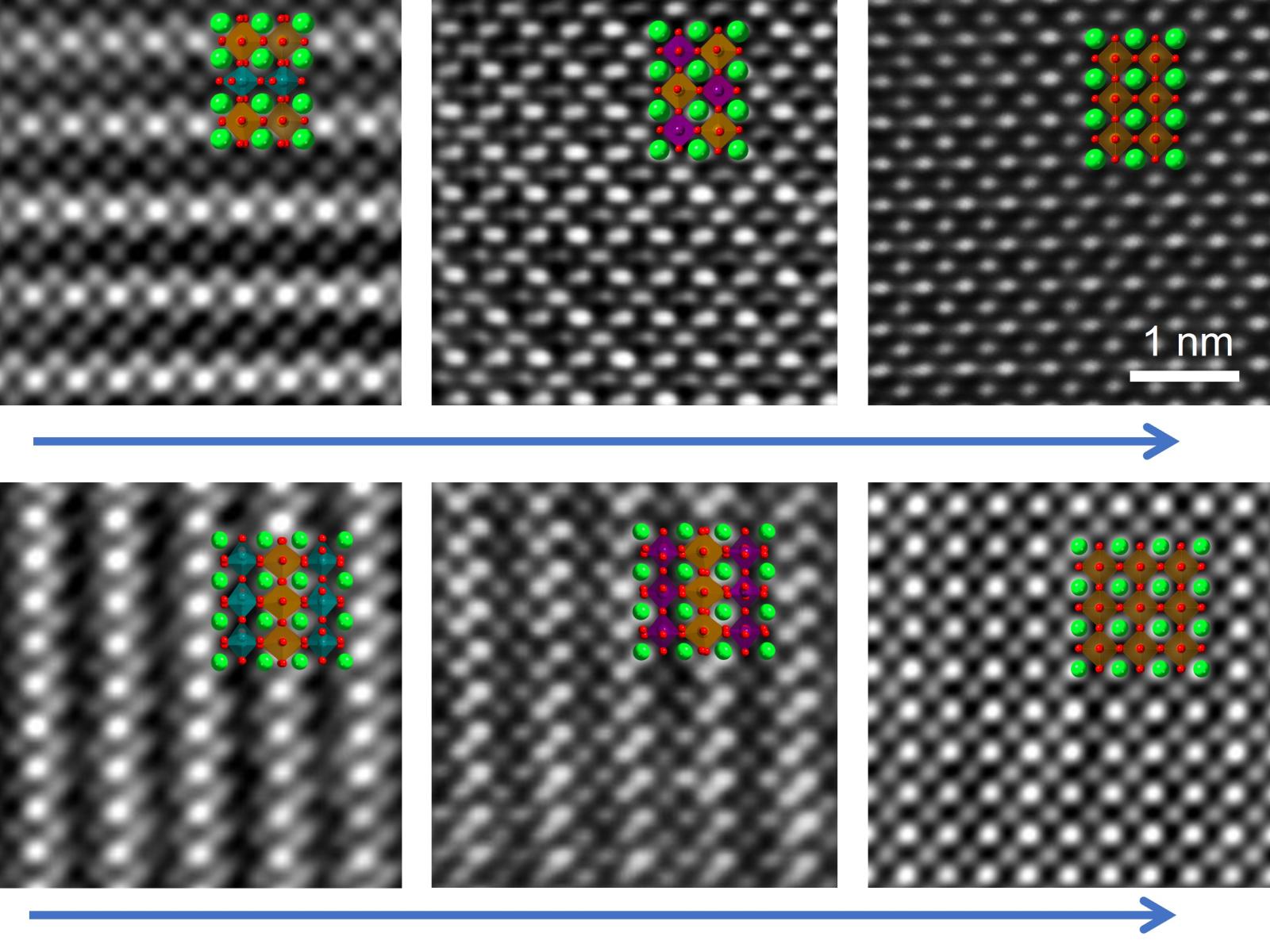Guided Anisotropic Oxygen Transport in Vacancy-Ordered Oxides
The pathway of oxygen ion movement can be controlled based on the initial structure and substrate of strontium iron oxide thin films

Oxygen ions move through two distinct pathways in strontium iron oxide thin films, converting from brownmillerite strontium iron oxide to perovskite strontium iron oxide.
(Image by Le Wang | Pacific Northwest National Laboratory)
The Science
The movement of ions is central to how energy conversion systems and microelectronics devices operate and fail. However, understanding exactly how ions move within materials is challenging due to the lack of tractable model systems and ways to monitor them. Researchers used in situ transmission electron microscopy (TEM) and epitaxially grown strontium iron oxide thin films to watch oxygen ions move in real time. The oxygen ions could be guided to move through one of two distinct pathways that lead to different intermediate phases depending on the initial structure of the strontium oxide film that is, in turn, determined by the substrate.
The Impact
Developing next-generation microelectronics and systems to manage energy requires understanding and controlling how ions move through materials. This work advances scientific understanding of how oxygen species move in a thin film system. By combining the in situ TEM imaging with computational modeling, the team was able to develop a robust picture of the different oxygen diffusion pathways. The principles identified here can help researchers develop better approaches to the rational design of oxide materials and devices that rely on ion movement to operate.
Summary
Complex oxides with the ability to accommodate significant amounts of oxygen vacancies in low-dimensional structures have long fascinated the scientific community. A persistent challenge remains in understanding how to order these vacancies, how to control their propagation, and how to control the transition between a potentially unlimited number of possible oxygen vacancies orderings with unique electronic signatures. At the core of this challenge is an inability to predictively initiate, observe, and direct topotactic phase transitions (TPTs).
A team of researchers has demonstrated the ability to directly manipulate and visualize oxygen diffusion at an atomic scale through in situ TEM. To investigate the details of anisotropic oxygen transport, the team synthesized a set of brownmillerite SrFeO2.5 (BM-SFO) thin films supported on multiple substrates using a pulsed laser deposition system. They found that the oxygen vacancy channels (OVCs) in the thin films can be stabilized to be either parallel to the interface or perpendicular to the interface. Then the team used in situ TEM to directly activate and image the topotactic phase transitions from BM-SFO to perovskite SrFeO3 (P-SFO), where oxygen ions are supplied from the reducible substrates under a built-up electric field created by electron beam irradiation. They observed that oxygen ion migration in vacancy ordered SrFeO2.5 thin films can be guided through two different diffusion pathways, each resulting in an intermediate SrFeO2.75 phase with different ground electronic properties. For OVCs parallel to the interface, oxygen diffusion involves restructuring of the lattice FeO6 octahedral and FeO4 tetrahedral sublayers (i.e., the phase transition from SrFeO2.5 to SrFeO2.75 proceeds through a disruptive diffusion process). In contrast, for OVCs perpendicular to the interface, unimpeded intercalation-only oxygen diffusion occurs and leads to an SrFeO2.75 phase containing alternating FeO6 octahedral and FeO5 pyramidal sublayers. This research advances the rational design of structurally ordered oxides for tailored applications and provides guidance for the development of devices that employ switching between multiple phase-controlled states.
PNNL Contact
Yingge Du, Pacific Northwest National Laboratory, yingge.du@pnnl.gov
Funding
The synthesis of the films and the in situ TEM work were supported by the Department of Energy (DOE), Office of Science (SC), Basic Energy Sciences (BES) program, Early Career Research program PNNL FWP 68278. ToF-SIMS characterization and DFT simulations were supported by the DOE BES Division of Materials Sciences and Engineering under Award No. 10122. A portion of the research was performed using EMSL, the Environmental Molecular Sciences Laboratory, a DOE user facility sponsored by the Biological and Environmental Research program and located at the Pacific Northwest National Laboratory. This research used resources of the National Energy Research Scientific Computing Center, a DOE SC user facility under award BES-ERCAP0021800.
Published: September 29, 2023
Yang Z., L. Wang, J. A. Dhas, M. H. Engelhard, M. E. Bowden, W. Liu, Z. Zhu, C. Wang, S. A. Chambers, P. V. Sushko, and Y. Du. 2023. “Guided Anisotropic Oxygen Transport in Vacancy-Ordered Oxides,” Nat. Commun., 14, 6068. [DOI: 10.1038/s41467-023-40746-4]